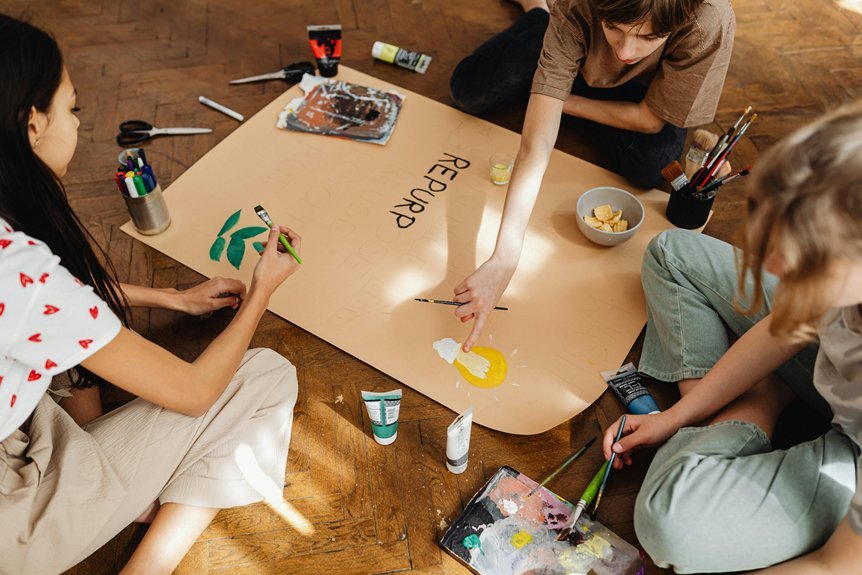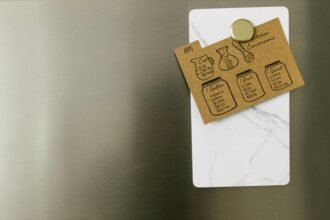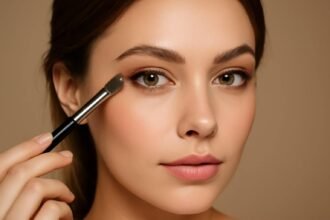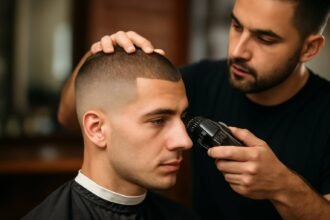If you want to start simple, assemble a student-grade acrylic set, a medium flat and a medium round brush, and a primed canvas panel or heavy watercolor paper. Add a plastic palette, two water cups—one for rinse, one for clean—and disposable towels. A silicone scraper keeps your palette clear. With these basics, you’ll cover most beginner techniques, control costs, and avoid frustration—next, you’ll choose the right types and sizes to match your first projects.
Key Takeaways
- Start with a student-grade paint set: acrylic for versatility, watercolor for transparency, gouache for matte coverage, or oil for slow blending.
- Get three brushes: medium flat, round, and small filbert; synthetic for water-media, hog bristle for oils.
- Choose the right surface: primed canvas or panels for acrylic/oil; 100% cotton watercolor paper for watercolor/gouache.
- Use proper palettes and containers: wet palette for acrylics, sealed wood/glass for oils, porcelain for watercolor; two water jars for clean mixing.
- Add budget-friendly extras: shop towels, scraper, freezer paper palette, basic mediums (gloss gel, linseed plus OMS), and nylon house brush for priming.
Essential Paint Types for Beginners
Canvas meets chemistry: as a beginner, you’ll choose among acrylic, watercolor, gouache, and oil—each with distinct binders, solvents, drying times, and handling.
Acrylic paints suspend pigments in an acrylic polymer emulsion; they’re water-thinnable, fast-drying, and form flexible films. You can glaze, scumble, or impasto with minimal waiting.
Acrylics: water-thinnable, fast-drying, flexible films for glazing, scumbling, and impasto with minimal waiting.
Watercolor mediums rely on gum arabic; they’re transparent, rewettable, and demand absorbent paper. Control value through dilution, not white pigment.
Gouache also uses gum arabic but adds higher pigment loads and opacifiers like calcium carbonate, yielding matte, velvety coverage and clean, graphic edges.
Oil paint disperses pigment in drying oils (linseed, safflower). It cures by oxidation, enabling extended blending and wet-into-wet work.
Choose student-grade sets to learn behavior, then upgrade key colors.
Brush Basics and What to Buy First
Although paint choice shapes your surface, brushes determine your mark. Start with three essential brush types: a medium flat (size 8–12) for blocking, a round (size 6–8) for lines and detail, and a small filbert (size 4–6) for soft edges.
Choose synthetic bristles for acrylics and watercolors; they spring back, resist swelling, and clean fast. For oils, consider natural hog bristle for stiffness or high-grade synthetics for solvent-free setups. Prioritize crimped, rustproof ferrules and balanced wooden or sealed handles.
Practice brush care from day one: never let paint dry in the heel, rinse between colors, reshape with water or mild soap, and dry flat with tips elevated.
Store horizontally or upright, tips up. Avoid crushing bristles in jars.
Surfaces and Paper That Work Well
Surface choice governs absorbency, tooth, and longevity, so match substrate to medium and technique. Evaluate canvas options, panels, and paper types by fiber, weight, sizing, and surface profile. For acrylics, primed cotton canvas and acrylic‑gessoed wood panels provide snap and quick layering. For oils, linen with alkyd‑primed ground resists sink‑in and preserves chroma. For watercolor, 100% cotton, 140–300 lb, internally and externally sized, prevents buckling and feathering. For gouache, hot press yields crisp edges; cold press offers controlled diffusion. Mixed media pads handle light washes and ink without pilling.
| Feel | Surface | Result |
|---|---|---|
| Calm | Hot press cotton | Glassy blends |
| Bold | Rough watercolor | Granular texture |
| Focused | Linen panel | Razor detail |
| Adventurous | Raw wood sealed | Organic pattern |
| Confident | Cotton canvas | Even handling |
Palettes, Water Containers, and Cleanup
With your support sealed and sized, your next variables are how you hold, dilute, and retire paint.
Prioritize palette selection by medium: for acrylics, use a lidded wet palette to slow evaporation; for oils, choose a sealed wood or glass palette for solvent resistance; for watercolor, opt for a porcelain or enamel well palette to keep washes clean.
Arrange warm-to-cool systematically to minimize cross‑contamination.
Use two water containers for water‑media: one for rinsing, one for clean dilutions. For oils, dedicate jars for solvent and medium, fitted with coil inserts to suspend pigments.
Keep disposable shop towels and a silicone scraper ready.
Apply strict cleanup tips: immediately wipe surplus paint, wash brushes with appropriate soap, decant sludge safely, and seal waste for proper disposal.
Budget-Friendly Extras and Smart Substitutions
Even on a tight budget, you can equip a capable studio by prioritizing function over branding and swapping costly consumables for proven stand-ins.
Select materials that deliver stable film formation, predictable drying, and reliable adhesion. Use alternative mediums judiciously: dilute gloss gel for glazing, or mix linseed with odorless mineral spirits for lean oil layers.
Build a compact kit of DIY tools to extend reach and control without premium prices.
- Cut acetate sheets as reusable palettes or tracing overlays.
- Repurpose plastic gift cards as scrapers and impasto knives.
- Mix cornstarch with water-based varnish for a controllable matte medium.
- Substitute freezer paper for palette paper; tape edges to stiff backing.
- Use nylon house brushes for priming and varnishing; reserve artist brushes for detail.
Conclusion
You’ve got the essentials to start painting without overspending. Choose student-grade acrylics, a medium flat and round brush, and a primed canvas or heavyweight watercolor paper. Set up a palette, two water containers, and disposable towels for efficient workflow. Use a silicone scraper to keep your palette clean. Add tape, a pencil, and a spray bottle as budget-friendly extras. With this streamlined kit, you’ll test techniques, control variables, and build skills quickly and confidently. Now, start painting.









